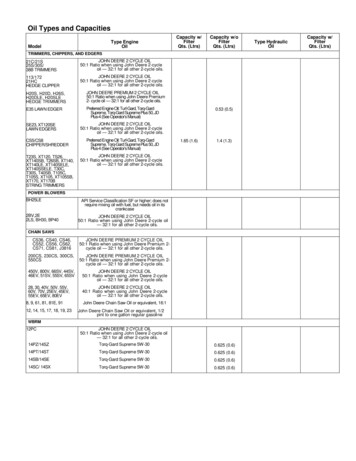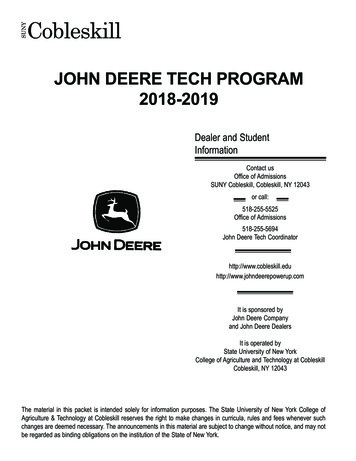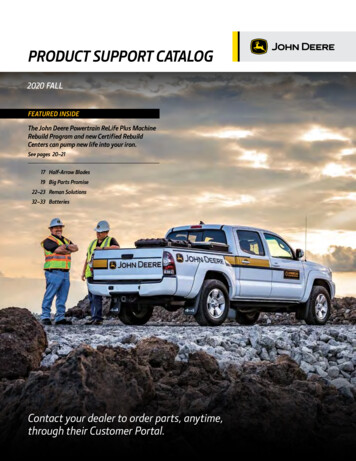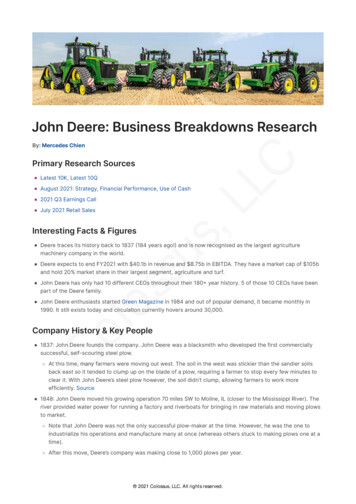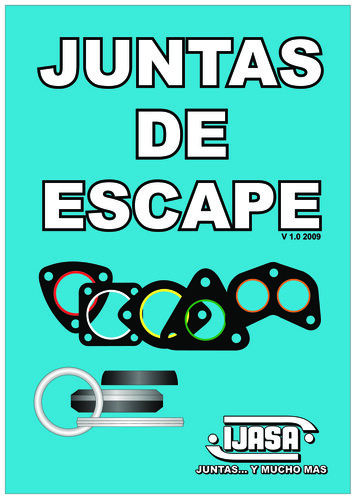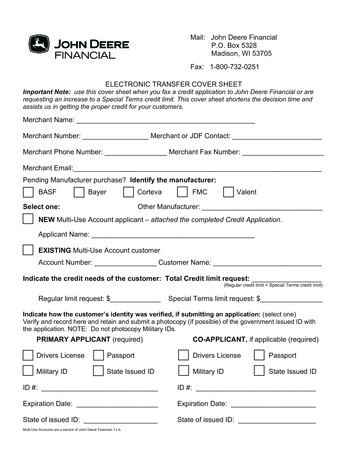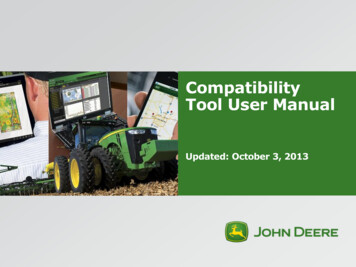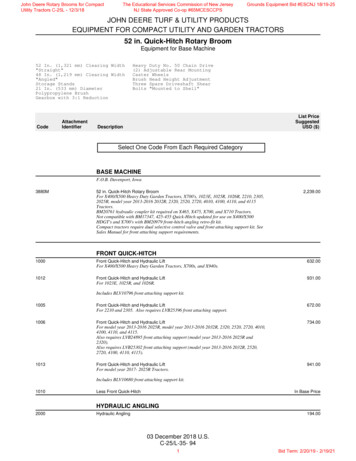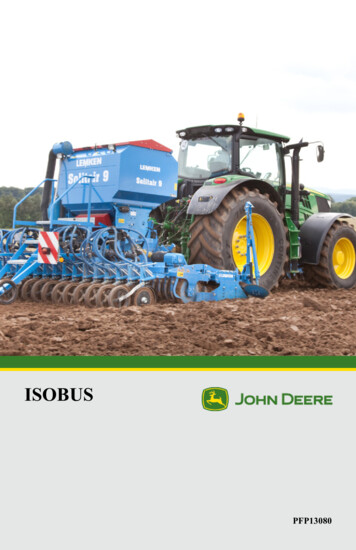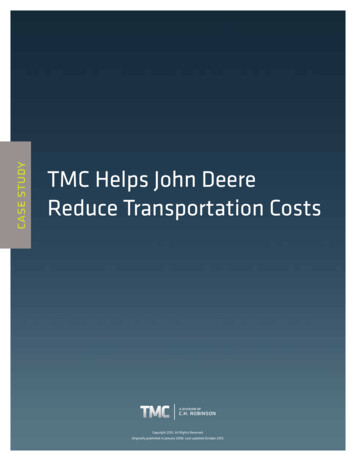
Transcription
case studyTMC Helps John DeereReduce Transportation CostsCopyright 2013. All Rights Reserved.Originally published in January 2008. Last updated October 2013.
John Deere’s inbound transportation was being managed by its suppliers,but TMC saw an opportunity for savings by creating an inbound consolidation program managed by TMC and John Deere.The ChallengeCreate an inbound transportation plan and successfully execute the strategyThe SolutionDevelop a command center at TMC for centralized management and execution of John Deere’s strategy nationwide, including network analysis, transportation modeling, a pool point program, and TMSimplementationThe ResultReduction of transportation costs through planning and optimization tools, streamlined processes, visibility, and metrics across the John Deere supplier baseThe FutureContinue the inbound optimization program and execute future process improvementsThe ChallengeJohn Deere was interested in working with TMC to reconfigure their current inbound transportationnetwork. Their existing model left most of John Deere’s freight under the management of their suppli-ers. Because John Deere works with several thousand suppliers, they were experiencing higher costs andinconsistencies within their inbound network.www.mytmc.com1
The SolutionObjectivesThe following objectives were created in collaboration with John Deere: To transition all inbound freight from a supplier-managed to a TMC/John Deere-managed state To create metrics to drive compliance To determine savings potential and create benchmarks for John Deere to measure against To deploy a software solution to optimize loads To perform transportation data analysis To provide John Deere with recommendations to reduce their inbound transportation spendApproachTMC began Phase One of the process by outlining four primary steps:Phase One1. Perform data collection and evaluation based on:a. North American inbound material shipmentsb. Service parts to John Deere distribution centersc. Returnable container shipments back to suppliers2. Determine scope of project based on data analysis3. Develop inbound freight scenarios and strategies4. Make inbound optimization recommendations to John DeereAfter collecting the data, TMC presented their findings to John Deere and recommended an inboundsolution that included software deployment, cross-docking, dedicated fleets, multi-stop truckload, andLTL consolidations.Re-engineered Statewww.mytmc.com2
ExecutionOnce John Deere and TMC had agreed on a solution, steps were taken to streamline all inbound freightprocesses. Currently, all of John Deere’s North American inbound freight is operating under the newinbound model. Based on these solutions, TMC and John Deere have:1. Defined and implemented a transportation procurement strategy2. Defined and managed a project plan-based implementation3. Developed and implemented a vendor compliance management program4. Defined the necessary metrics and benchmarks for analysis and process improvementsThe next step was to deploy the TMC optimization software and integrate it into the new inboundmodel. As of third quarter 2007, all of John Deere’s inbound freight transactions will be operating withthis technology. The optimization software process is as follows:1. Suppliers enter their shipment data into the TMC online system2. TMC filters the shipment data to facilitate order and mode optimization3. Optimized shipments tender to John Deere’s inbound carriers4. Business intelligence tools monitor the process and resultsThe ResultAs the new inbound optimization model continues to be executed across North America, John Deere isexperiencing these key successes:1. Reduced transportation costs2. Understanding of regional density: Creation of business rules Carrier capacity and rate requirements Potential infrastructure and dedicated operations3. Increased CSR productivity4. Metrics to measure program success5. Aligned teamwork between John Deere and TMCwww.mytmc.com3
The FutureJohn Deere and TMC will continue to align their resources, analyze the new inbound optimizationmodel, and remain dedicated to continuous process improvements. Phase Two is projected as follows:Phase Two1. Continue to execute and analyze the inbound optimization model2. Determine the appropriate thresholds needed to expand the model beyondPhase OneJohn Deere and TMC share similar goals for the success of John Deere’s transportation network andview the inbound freight optimization as a catalyst for future process improvements and savings.Supplier Implementation by Geographywww.mytmc.com4
About TMC and Managed TMS TMC is a division of C.H. Robinson, one of the world’s largest providers of global freight services. Theirglobal Managed TMS solution offers TMS technology combined with managed services. ThroughControl Towers in Chicago, Amsterdam, Shanghai, and Mumbai, TMC coordinates complex, global,multi-leg shipments, using all forms of transportation. With the Managed TMS solution—deliveredthrough TMC—clients are provided a single global platform for shipment optimization and visibility,freight payment, and business intelligence. C.H. Robinson employs hundreds of transportation experts tosupport Managed TMS clients in North and South America, Europe, Asia, Africa, and the Middle East.For additional information on Managed TMS and global Control Towers, go to www.mytmc.com.For powerful new ideas in freight management, visit the TMC Connect blog at www.mytmc.com/blog.www.mytmc.com5
John Deere was interested in working with TMC to reconfigure their current inbound transportation network. Their existing model left most of John Deere's freight under the management of their suppli-ers. Because John Deere works with several thousand suppliers, they were experiencing higher costs and inconsistencies within their inbound network.
